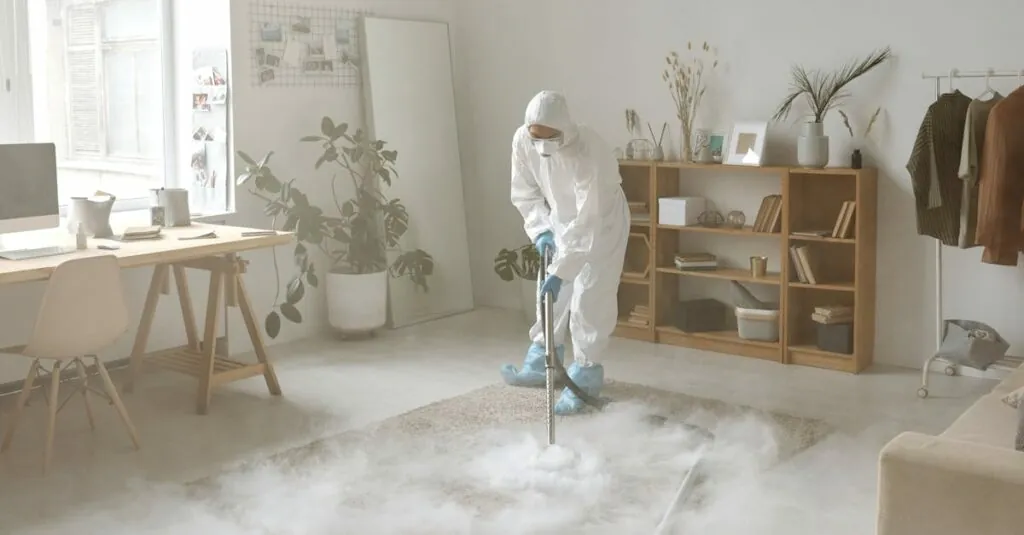Table of Contents
ToggleMeasuring a room for carpet installation might sound as thrilling as watching paint dry, but it doesn’t have to be a snooze fest. With the right approach, it can be as easy as pie—and just as satisfying when you finally lay down that plush carpet. Imagine sinking your toes into a soft, inviting surface that fits your space perfectly.
Understanding The Importance Of Accurate Measurements
Accurate measurements play a critical role in carpet installation. Precise dimensions ensure a proper fit, reducing the chances of waste and costly mistakes. When measurements are incorrect, the likelihood of gaps or excess carpet increases, leading to an unprofessional appearance.
Taking detailed measurements contributes to effective planning. Homeowners and installers can determine the appropriate amount of carpet needed, minimizing unnecessary purchases. This approach not only saves money but also simplifies the installation process.
Each measurement should include all relevant areas. It’s essential to account for unique room shapes, alcoves, and recesses that may require additional considerations. These variations can impact the overall layout and design of the carpet.
Using tools like a tape measure guarantees accuracy. Measuring from wall to wall provides the most reliable data. Adding a few extra inches can help accommodate any adjustments needed during installation.
Documenting measurements creates a valuable reference. By keeping detailed notes, individuals can revisit their data if questions arise. Sharing accurate figures with installers also ensures clarity and efficiency in the project.
Overall, understanding the significance of accurate measurements leads to a smoother carpet installation experience. By prioritizing this step, individuals enhance the outcome and increase satisfaction with their new flooring.
Tools Needed For Measuring
Accurate measurements depend on using the right tools. Gathering specific items before starting the process ensures efficiency and precision.
Measuring Tape
A measuring tape serves as the primary tool for capturing measurements. It’s essential to select a tape that extends at least 25 feet, accommodating most room sizes. Flexibility aids in navigating corners and tight spots. Look for a tape with clear, easy-to-read markings to enhance accuracy. Measuring multiple times prevents errors and provides confidence in the recorded dimensions.
Notepad And Pencil
He’ll find that a notepad and pencil become vital for keeping track of measurements. Recording figures helps prevent confusion later. Organizing numbers by room ensures clarity when planning and purchasing carpet. Jotting down any specific features, such as alcoves or doorways, supports an effective layout when selecting carpet size. A systematic approach to note-taking streamlines the entire installation process.
Step-By-Step Guide On How To Measure A Room For Carpet Installation
Measuring a room for carpet installation involves precise steps to ensure a perfect fit. Accurate measurements save money and improve the overall aesthetic of the space.
Measuring The Length And Width
Start by measuring the length of the room. Use a tape measure that extends at least 25 feet for optimal reach. Walk the tape from one end to the other and record the measurement. Next, measure the width in the same way. Each measurement should reflect the furthest points, including any nooks or recesses. Document these dimensions clearly in your notebook, noting the room name and any special features. Ensure to double-check each measurement to avoid costly mistakes.
Accounting For Irregular Shapes
Rooms often feature irregular shapes that complicate measurements. To address this, break the space into smaller rectangles or squares. First, measure each section’s length and width individually, just as before. Calculate the area of each section by multiplying the length by the width. Then, sum the areas to determine the total square footage of the room. Always include alcoves and doorways in your calculations. This method ensures an accurate measurement, allowing for a better carpet fit.
Calculating Carpet Needs
Accurate calculations ensure homeowners order the right amount of carpet for installation. Each step in this process contributes to achieving a perfect fit for maximum satisfaction.
Converting Measurements To Square Feet
To convert room dimensions into square feet, multiply the length by the width. This straightforward calculation provides the total area required. For instance, a room measuring 10 feet by 12 feet equals 120 square feet. In cases where a room features alcoves or angles, break the area into smaller rectangular sections. Measure each section, convert each to square feet, and add the total. This method ensures precision, addressing any irregularities in the room shape while confirming the necessary carpet area.
Adding Extra For Waste
Including extra material for waste is crucial in carpet installation. Carpets often require additional footage to account for cuts and imperfections. A common recommendation is to add 10% to the total square footage calculated. For a 120 square foot room, this equates to an additional 12 square feet, bringing the total to 132 square feet. By preparing for excess, homeowners minimize the risk of needing to reorder material, ensuring a smoother installation process.
Preparing For Installation
Before starting carpet installation, clear the room of furniture and other items. Removing obstacles creates a safe space for measuring and minimizes distractions. Ensure the floor is clean and dry to aid in accurate measurements.
Gather essential tools like a measuring tape, a notepad, and a pencil. A measuring tape that extends at least 25 feet provides flexibility for larger rooms. Document measurements systematically on the notepad, organizing them by room and addressing features like alcoves or doorways.
Consider marking the room’s dimensions on the floor with chalk or masking tape. Visualizing the layout aids in understanding how the carpet will fit within the space. When measuring each section, do this twice to ensure accuracy.
For irregular spaces, divide the area into smaller rectangles or squares. This method simplifies complex shapes, allowing for precise square footage calculations. Measure each section carefully, then add the total measurements together.
Calculate the amount of carpet needed by converting measurements into square feet. Multiply the length by the width of each section to find total area. Always include an extra 10% for waste, which accommodates cuts and imperfections during installation.
Review the prepared measurements before placing a carpet order. Taking this extra step reduces the likelihood of reordering material, making the installation process smoother. Prioritizing meticulous preparation enhances the overall success of the carpet installation.
Measuring a room for carpet installation is a crucial step that can significantly impact the final result. By using the right tools and following a systematic approach, homeowners can ensure accurate measurements that lead to a perfect fit. This not only enhances the aesthetic appeal of the space but also avoids unnecessary costs associated with waste and reordering.
Taking the time to plan and document measurements effectively pays off in the long run. With careful preparation and attention to detail, the carpet installation process becomes smoother and more enjoyable. Ultimately, achieving a well-fitted carpet transforms a room into a cozy and inviting area that everyone can appreciate.







